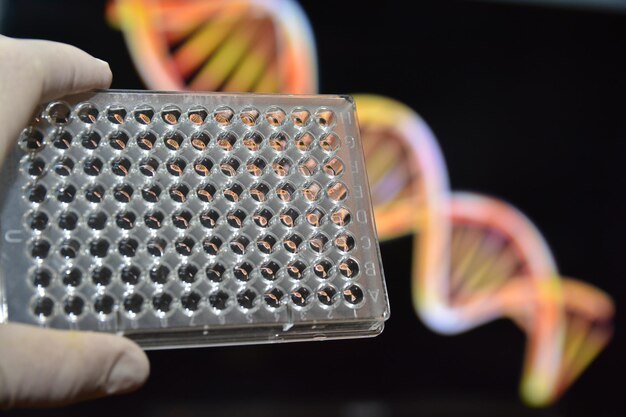AncestryDNA Traits Test Review: Unveiling the Secrets of Accuracy

The AncestryDNA Traits test analyzes your DNA to predict traits, but accuracy varies; while some traits are reliably linked to genetics, others are more complex and influenced by environmental factors, making the test an informative but not definitive predictor.
Unveiling the Secrets: A Review of the AncestryDNA Traits Test – Is It Accurate? is a critical question for anyone considering this service. While ancestry DNA tests have become increasingly popular, understanding the accuracy of the traits component can help manage expectations and inform decisions.
Understanding the AncestryDNA Traits Test
The AncestryDNA Traits test is an extension of the standard AncestryDNA service, offering insights into various personal characteristics based on your genetic makeup. It goes beyond ancestry to explore how your DNA might influence traits like eye color, hair texture, and even certain aspects of your personality.
What Traits Does It Cover?
The AncestryDNA Traits test covers a wide range of characteristics, from physical features to sensory perceptions. The test aims to provide a comprehensive overview of what your DNA suggests about you.
- Physical Traits: Predicting features like eye color, hair color, hair type, skin pigmentation, and likelihood of freckles.
- Sensory Perception: Including traits related to taste preferences (like cilantro aversion), smell sensitivity, and pain tolerance.
- Other Characteristics: Covering traits like willingness to take risks, deep sleep, and memory performance.
It is important to approach the results with an understanding of the limitations of genetic trait prediction. Genes play a crucial role, but environmental factors also contribute significantly to the expression of many traits.
How the AncestryDNA Traits Test Works
Understanding how the AncestryDNA Traits test processes your DNA sample is key to assessing its accuracy. This involves detailed steps that ensure your results are reliable.

The DNA Analysis Process
The AncestryDNA Traits test relies on analyzing specific genetic markers (SNPs – single nucleotide polymorphisms) in your DNA. These markers are known to be associated with certain traits based on extensive scientific research.
Once you send in your saliva sample, the DNA is extracted, amplified, and then analyzed using microarray technology. This technology can simultaneously analyze hundreds of thousands of genetic markers.
After the analysis, a complex algorithm interprets the data and predicts your traits based on the combination of genetic markers present in your DNA.
Interpreting the Results
The results of the AncestryDNA Traits test are presented in an easy-to-understand format, often with interactive visuals and detailed explanations. The interpretation includes the likelihood of expressing each trait based on your genetic data.
- The test reports provide insights into how specific genes influence each trait.
- Results may include comparisons to the general population to show how your genetic predispositions stack up against others.
- AncestryDNA also offers educational content to help you understand the science behind each trait and the factors that influence its expression.
Remember that while these results are informative, they are not definitive. The expression of many traits is influenced by a combination of genetic and environmental factors.
Accuracy of Physical Feature Predictions
One of the most intriguing aspects of the AncestryDNA Traits test is its ability to predict physical features. While some of these predictions are quite accurate, others are less reliable due to the complexity of genetic inheritance.
Eye Color and Hair Color
Eye color prediction is generally one of the more accurate traits that can be determined through DNA analysis. Several well-studied genes, such as OCA2 and HERC2, play a significant role in determining eye color.
Hair color prediction is also fairly reliable, although more complex than eye color. Multiple genes influence hair color, including MC1R, which has different variants that can produce a range of hair colors.
Keep in mind that while the major genes can provide a good prediction, less common genetic variations and gene interactions can affect the final outcome.
Other Physical Traits
Predictions for traits like skin pigmentation and freckling are moderately accurate but can be influenced by environmental factors like sun exposure. These traits are governed by multiple genes, making the predictions less straightforward than for single-gene traits.
Traits like height and weight are far more complex and are influenced by hundreds of genes, as well as environmental factors like diet and exercise. As a result, genetic predictions for these traits are less accurate.
The accuracy of physical trait predictions largely depends on the trait’s genetic architecture – whether it is determined by a single gene or multiple genes, and the extent of environmental influence.
Accuracy of Sensory and Behavioral Predictions
The AncestryDNA Traits test also delves into predicting sensory perceptions and behavioral traits. These are often more challenging to predict accurately because they are influenced by a combination of genetic and environmental factors.

Taste and Smell Sensitivities
Some sensory traits, like the ability to taste certain compounds (e.g., cilantro aversion), have a strong genetic component and can be predicted with reasonable accuracy. The gene associated with cilantro aversion, OR6A2, has been well-researched.
Other sensory traits, such as the perception of bitterness or sweetness, are influenced by multiple genes and personal habits, making them harder to predict solely from DNA analysis.
- The reliability of taste and smell predictions depends on the specific genetic markers analyzed.
- Environmental factors such as diet and exposure to different smells play a critical role.
- Personal experiences and preferences also influence how individuals perceive and react to different tastes and smells.
Behavioral Traits
Behavioral traits, such as risk-taking tendencies or deep sleep patterns, are even more intricate. These traits are affected by a complex interplay of genes, environment, and personal experiences. Genetic predictions in this area should be approached with caution.
While certain genetic markers may be associated with specific behavioral tendencies, the influence of these genes can vary significantly from person to person. Environmental factors such as upbringing, education, and social environment can significantly impact behavior.
The predictive accuracy of behavioral traits is limited, and the results should be regarded as potential predispositions rather than definitive outcomes.
Factors Influencing the Accuracy of the Test
Several factors can influence the accuracy of the AncestryDNA Traits test. Understanding these factors can help you interpret your results more effectively and appreciate the complexities of genetic trait prediction.
Genetic Complexity
As mentioned earlier, the genetic architecture of a trait is a key determinant of prediction accuracy. Traits controlled by a single gene tend to be more accurately predicted than those influenced by multiple genes.
Complex traits, which involve numerous genes interacting with each other, are more challenging to predict due to the vast number of possible combinations and interactions.
Traits like height, weight, and behavioral tendencies are prime examples of complex traits with lower prediction accuracy.
Environmental Factors
Environmental factors play a crucial role in the expression of many traits. Even if your DNA suggests a certain predisposition, environmental influences can modify the outcome.
For example, your genes might suggest a higher likelihood of muscle mass, but without proper exercise and nutrition, you may not develop significant muscle mass. Similarly, genetic predispositions to certain diseases can be mitigated by a healthy lifestyle.
Environmental factors introduce variability and complexity, making precise predictions more difficult.
Database and Algorithm Accuracy
The accuracy of the AncestryDNA Traits test also depends on the robustness of the database used to identify gene-trait associations and the sophistication of the algorithm used to interpret the genetic data. The larger and more diverse the database, the more reliable the predictions.
The algorithm must accurately account for gene interactions and population-specific genetic variations.
- The quality of the scientific research linking genetic markers to traits is critical.
- Regular updates to the database and algorithm improve the accuracy of predictions.
- Transparency about the data sources and methodologies used by AncestryDNA builds trust in the results.
Ongoing research and technological advancements continue to enhance the accuracy and reliability of genetic trait predictions.
Tips for Interpreting Your AncestryDNA Traits Results
Interpreting your AncestryDNA Traits results requires careful consideration and a balanced perspective. These tips can help you make the most of your results while understanding their limitations.
| Key Point | Brief Description |
|---|---|
| 🧬 Genetic Predisposition | Understand traits are predispositions influenced by genes. |
| 🌳 Environmental Impact | Environment and lifestyle also shape how traits manifest. |
| 🔬 Scientific Accuracy | Accuracy varies based on the genetic trait’s complexity. |
| 📊 Population Diversity | Interpret results with an understanding of population genetics. |
Frequently Asked Questions
▼
The AncestryDNA Traits test is quite accurate for predicting eye color, especially for blue and brown eyes, as these are determined by well-studied genes like OCA2 and HERC2. However, predicting less common eye colors can be less precise.
▼
Predicting behavioral traits like risk-taking is challenging due to the complex interplay of genes, environment, and personal experiences. The test provides insights, but consider these as predispositions rather than definitive outcomes.
▼
While the test analyzes your DNA, it primarily focuses on genetic predispositions. Environmental factors significantly influence how traits are expressed, so the test results should be interpreted with this in mind.
▼
AncestryDNA regularly updates its database and algorithms to incorporate the latest scientific research and improve the accuracy of predictions. These updates enhance the reliability and relevance of the test results over time.
▼
If your AncestryDNA Traits results don’t match your actual traits, remember that genetic predispositions are not definitive. Environmental factors and gene interactions can lead to variations, so view your results as informative rather than conclusive.
Conclusion
In conclusion, the AncestryDNA Traits test offers valuable insights into your genetic predispositions for various traits. While the accuracy varies depending on the trait’s genetic complexity and the influence of environmental factors, understanding these nuances can help you interpret the results effectively. Use the test as a tool for self-discovery, but always consider the broader context of your life experiences and environmental influences.





